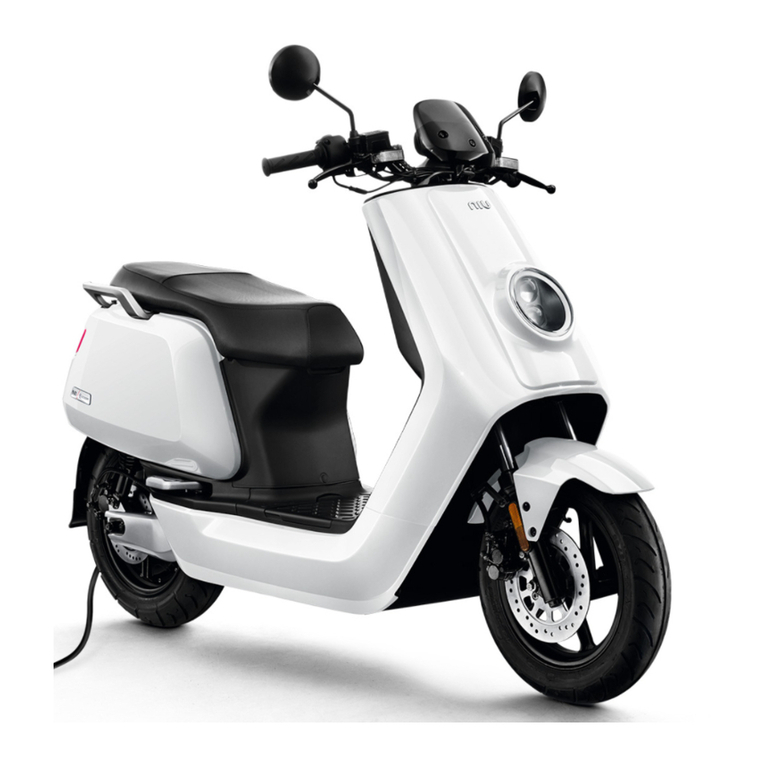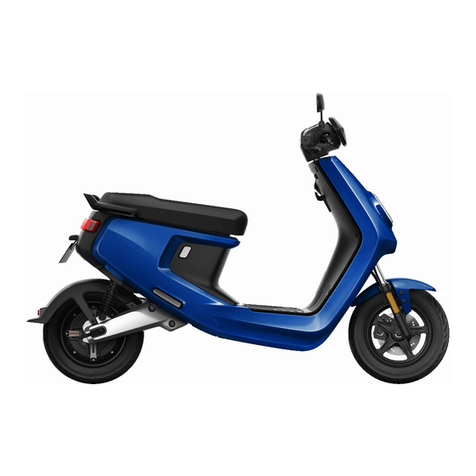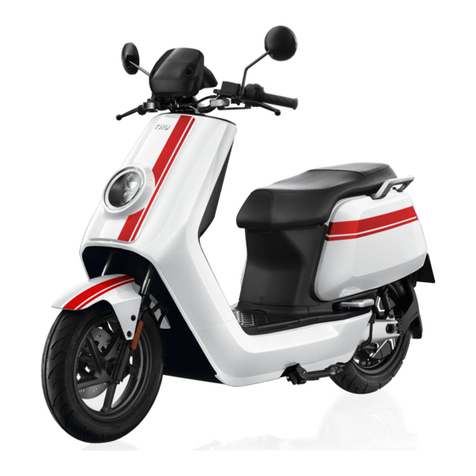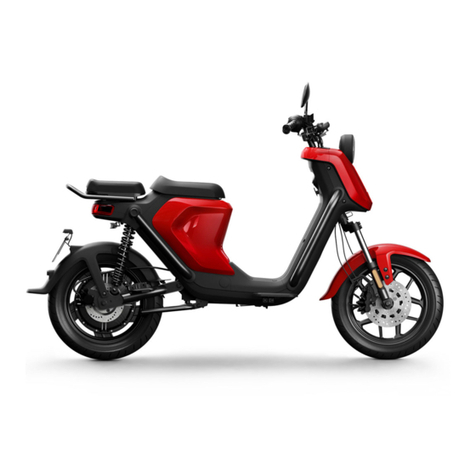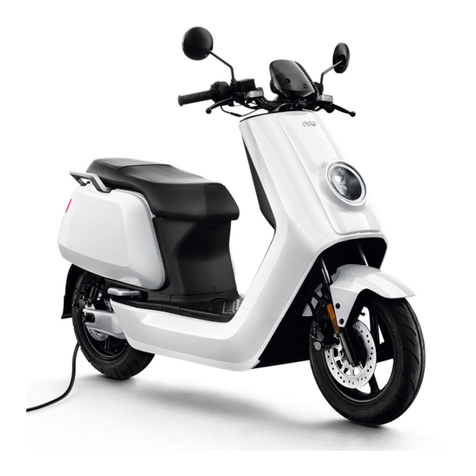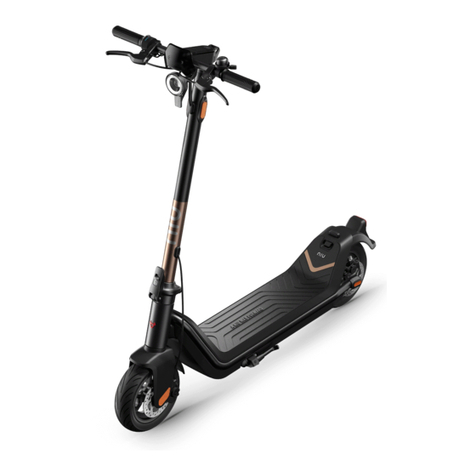niu Kick Scooter KQi3 User manual

V1.0.0
1
Kick Scooter KQi3
Service Manual
Jiangsu Niu Electric Technology Co. Ltd

V1.0.0
2
Contents
Foreword
2
Part Names
6
Scooter Identification
7
Overall specifications
8
Parts Removal and Installation Procedure
11
Preparation
11
forehead body
12
dashboard and dashboard cover
14
headlamp
18
handlebar
21
pedal
28
controller and battery pack
32
rear wheel and rear wheel fender
46
folding parts
50
front fork and front wheel
54
Wiring Diagram
59
Fault Codes
60

V1.0.0
3
Foreword
Key points in maintenance of Niu KQi3 are described in this maintenance manual.
Preparations in the maintenance manual include notes to all operations. Please read the manual
carefully before operating.
Key points in the inspection and adjustment, including maintenance methods for scooter safety and
component performance that are applied from regular examinations, are described.
Chapters are edited with disassembly diagrams, system figures and instructions about the maintenance
and failure diagnosis.
Note:
Modifications of scooter version or structure as well as photos, pictures or instructions in the manual are
referred to physical objects without further notice.
Maintenance Information
The maintenance and reparation information contained in this manual is for technical specialists only.
Maintenance or reparation performed by those who are not trained properly and provided with
appropriate tools and equipment may cause injuries to themselves or others and also lead to damages
or unsafe conditions of the scooter.
The proper maintenance and reparation procedures, some of which require special tools and equipment,
are described in this manual. The risks in terms of personal safety and scooter operation safety, which
may be resulted from the use of components, maintenance procedures or tools not recommended by
Niu must be verified.
Please make replacement with original electric components made by Niu or equivalents that have
corresponding part numbers. We strongly recommend you not to use inferior components.
Customer Safety Notice
The proper maintenance is crucial for customer safety and scooter reliability. Any errors or omissions in
scooter maintenance may result in operating malfunctions, scooter damages or injuries.
Improper maintenance or reparation may lead to unsafe conditions under which serious injuries or even
death of your customers or other people may be incurred.
Please carefully follow the procedures and cautions in this manual and other maintenance materials.
Personal Safety Notice
This manual is used only by professional maintenance technicians, and the warning information about
multiple basic workshop safety operation procedures (such as the procedure that requires gloves when
working on hot components) is n=ot set forth herein. We recommend you not to carry out procedures
specified in this manual without readiness if you have not received the workshop safety training or
grasped the knowledge about maintenance safety specifications.
The following are listed as several most importance general notes to maintenance safety. However, we
are unable to set forth the warning for each of risks that may arise from maintenance and reparation
procedures. You have to determine at your discretion whether a detail task should be implemented.
Failure to properly follow relevant instructions and notes may result in serious injuries or even death.
Please carefully follow procedures and notes in this manual

V1.0.0
4
Maintenance Rules
1. Metric tools should be made as available as possible in the maintenance of the scooter. Use of improper
tools may damage the scooter.
2 Clean off the dirt outside parts or assemblies of the chassis or braking system before guard removal from
the scooter or opening for maintenance.
3 Please clean parts and blow them with an air compressor after removal and before measurement of the
wearing value.
4 Rubber parts that have become aged or deteriorated are very easy to be damaged by the solvent or oil.
They should be checked or replaced if necessary before reassembly.
5. Multiple assemblies should be loosened in the sequence from outside to inside and beginning with small
ones.
6. Complex assemblies should be stored in a proper installation sequence for further assembling.
7 Extra attention should be paid to important fitting positions before disassembling. Parts that are no longer
to be used should be replaced before disassembly.
8 The bolt or screw length varies with assemblies and guards. Bolts or screws must be installed at correct
positions. A bolt can be placed into a bolt hole for fitness in case of confusion.
Important notes
1.Please use original parts made by Niu. Use of components that are not in compliance with design
specifications by Niu Company may cause damages to the scooter.
2.Maintenance operations can be performed only with metric tools. The metric bolts, nuts and screws can
not be interchanged with British fasteners.
3.The replacement with new washers, O rings, split pins and lock shims should be made for reassembly.
4.Bolts or nuts should be tightened by beginning with large-diameter bolts or inward bolts and then
gradually tightening to specified torques diagonally, unless otherwise indicated.
5.Clean components that have been removed with the detergent solution. All the sliding faces should be
lubricated before assembling.
6.Check all components for the proper installation and operating after assembly.
7.Remove the dirt and oil stains before measurement. Apply recommended lubricants to sections to be
lubricated during assembly.
8.Apply the lubricant to part surfaces to avoid rusting and dust accumulation, if the engine and transmission
systems need to be stored for a long time after disassembling.
Cable connector inspection
•Loose cables constitute a risk to electric safety. Cables should be checked after their clamping to ensure
electric safety.
•Bending of cable clamps towards welding points is not allowed.
•Cables are bound at designated positions.
•Cable placement at the scooter frame end or a sharp angle is not allowed.
•Cable placement at the bolt or screw end is not allowed.
•Cable placement should be made away from thermal sources or positions where cables may be stuck in
moving.
•The cable placement along stem handles should not be made too tight or loose and should not interfere
with adjacent parts at any steering positions.
•Cables should be placed smoothly without being twisted or tied.
•Verify whether the connector shroud is damaged or the connector is excessively open before connecting.
•Please protect the cable at a sharp angle or turning position with adhesive tapes or a hose.
•Cables should be bound reliably with adhesive tapes after reparation.
•Controlling cables should not be bent or twisted. The controlling would not be flexible if controlling cables
were damaged.

V1.0.0
5
Importance Safety Notes
Make sure that you have completely understood basic workshop operation safety
procedures and taken on proper protective clothes and are provided with safety
equipment. Extra attention should be paid to the following in the implementation of a
maintenance task:
•Read all the relevant instructions before operation, and make sure that you have
necessary tools, spare parts, components and skills to implement a maintenance task
safely and completely.
•There are high-voltage circuits in the scooter system, which can cause electric shock. It
must be verified that your maintenance site, tools, protective equipment and operation
procedures are in compliance with the insulation requirement.
•Eyes should be protected with proper safety glasses, goggles or masks in operations
such as hammering, drilling, polishing or prying or working around high-pressure air or
fluid tanks, springs or other energy storage components. Eye protection devices should
be worn as long as there are suspicious conditions.
•Other protection devices such as gloves or safety shoes are used where necessary.
Gloves should be worn before handling of a hot or sharp component that may cause
serious burns or cuts or grasping of any things that may cause injuries.
•Measures should be taken to protect you and others once a scooter is lifted. Make sure
that the scooter is always supported stably when being lifted with a crane or jacks.
Please use jack mounts.
•The hot motor after driving for a long time may cause burns. Wait for the motor to
cool down before working on it.
•Moving parts can cause injuries. Make sure that your hands, fingers and clothes are not
obstructive.
•Components must be cleaned with non-flammable solvents instead of the gasoline.
•All components related to a storage battery should be away from cigarettes, sparks and
flames.
This manual suits for next models
2
Table of contents
Other niu Scooter manuals
